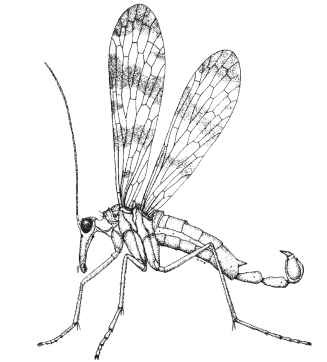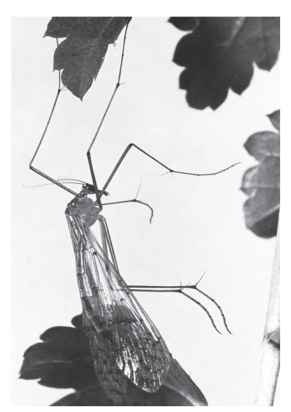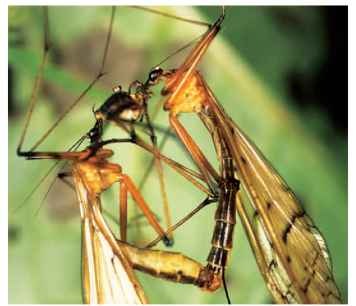Mecoptera (scorpionflies, hangingflies, and others) are holomet-abolous insects in which the head is characterized by a downward projecting rostrum or beak, at the end of which are chewing mouth-parts. They are usually slender bodied and have four long, narrow wings that are membranous and often marked with dark bands, spots, or darkening along the numerous crossveins. There are exceptions, however. A few species are brachypterous or wingless; species in family Boreidae have hardened, highly modified wings, which are nearly oval and scalelike in females, slender and somewhat curved apically in males. The rostrum is not unusually prolonged in species of Nannochoristidae; and the wings of species of Meropeidae are only about 2.5 times longer than their greatest width. Although Mecoptera are one of the minor orders of insects, with only about 570 living species so far made known, they are of much interest to entomologists. This is largely because fossil Mecoptera are among the oldest remains of insects with complete metamorphosis (of Permian age) and have been regarded by some as ancestral to the more recently evolved and vastly larger orders Diptera and Lepidoptera. Fossil evidence suggests that the Mecoptera were once one of the larger orders of holometabolous insects. Past diversity, based mainly on wing venation, has led to placement of nearly 400 fossil species in 87 genera in 34 families. Thus, modern Mecoptera are survivors of millions of years of evolutionary development.
FAMILIES AND GENERA
Following are the nine families of extant Mecoptera, with the number of genera included in each and the approximate geographical distribution: Panorpidae—3 genera, in Europe, Asia, and North
America; Panorpodidae—2 genera, in easternmost Asia and North America; Bittacidae—19 genera, in North and South America, Africa, Asia, Australia, and Europe; Boreidae—3 genera, in North America, Asia, and Europe; Choristidae—3 genera, in Australia; Nannochoristidae—2 genera, in Australia, New Zealand, and southern South America; Apteropanorpidae—1 genus, in Australia (Tasmania); Meropeidae—2 genera, in North America and southwestern Australia; Eomeropidae (formerly Notiothaumidae)— 1 genus, in South America.
Most Mecoptera belong to the families Panorpidae (scorpionflies) and Bittacidae (hangingflies). Scorpionflies are so called because abdominal segments 7 and 8 of the male are slender, and segment 9 is abruptly enlarged and often held above the back, recalling the sting of a scorpion (Fig. 1). The female abdomen tapers to a slender tip. Both male and female hangingflies are slender bodied and, having a single, large (raptorial) claw at the end of each tarsus, are unable to stand on the upper surfaces of leaves but suspend themselves from twigs or edges of leaves (Fig. 2).

FIGURE 1 A male scorpionfly showing anatomical characteristics of family Panorpidae. Length of forewing is 12 mm.
ZOOGEOGRAPHY
Mecoptera present a variety of zoogeographical patterns, from highly localized (as in Notiothauma, which is endemic in central Chile, or Apteropanorpa, found only in Tasmania) to virtually cosmopolitan (as the Bittacidae, which occur in the temperate and tropical parts of six continents). Only Bittacidae have been found in Africa. Some very disjunct occurrences suggest relics of ancient, more widespread ranges (as Merope in eastern North America and the very similar Austromerope in southwestern Australia; or Nannochoristidae in southeastern Australia, New Zealand, and southern South America).

FIGURE 2 A hangingfly, Bittacus sp., in characteristic, resting posture. Length of forewing is 19 mm.
HABITAT
Broad-leaved, herbaceous plants shaded by trees are the usual habitat of panorpids, bittacids, and most species in the smaller families. Some species, however, are most commonly found in vegetation near forest borders, whereas others occur in somewhat similar but more uniformly shaded habitats well within a forest. Elevation clearly affects the distribution of Mecoptera. Boreidae, for example, reach the adult stage in the cold part of the year (and being darkly colored are most often seen on the surface of snow) and at high elevations and high latitudes have a longer seasonal occurrence than boreids at lower elevations. In Mexico, Bittacidae are usually found at elevations below 1500 m, while Panorpidae occur above that level and up to over 3000 m.
DIET
Both adults and larvae of Panorpa are scavengers, feeding usually on dead insects, and less often on other dead organisms, including some small vertebrates. Adults occasionally eat pollen and associated parts of flowers; they may even invade the webs of spiders to feed on entangled insects (and are sometimes trapped themselves). Adult Bittacidae (Fig. 2) are predaceous, capturing a variety of insects and occasionally other arthropods by means of the raptorial hind tarsi. Larval bittacids, in contrast, are primarily saprophagous on dead insects but may occasionally feed on mosses. Adults of Brachypanorpa (Panorpodidae) have been observed scraping the upper epidermis from leaves of herbaceous plants; their larval diet is not known. There is some evidence that Notiothauma (Eomeropidae) is also a plant feeder. Aquatic larvae of Nannochoristidae feed on small larvae of chironomid flies, but nothing is known of the adult diet.
BEHAVIOR
Feeding by adults of some Mecoptera is often associated with mating behavior (Fig. 3). Some male bittacids, for example, capture insects as nuptial gifts, then extrude pheromone-dispersing vesicles between abdominal terga 6-7 and 7-8 to advertise their presence to females in the vicinity. Females seem to make an evaluation of the gift prey, leaving the male if his offering is too small or unpalatable. They may then respond to the pheromone of another male. Males of some Panorpidae, when they have found a good source of food, make known their presence by means of pheromonal vesicles within the enlarged genital segment. When a female is attracted closely enough, the male clamps the costal edge of her forewing in a structure formed by a peg on the anterior fourth abdominal tergum and an overlapping portion of the third (the notal organ); mating then ensues as the female feeds. In other species of Panorpa, the male may build a small column of brownish saliva, gelatinous as it air-dries, which serves as a nuptial gift in place of a dead insect.

FIGURE 3 Mating pair of Japanese bittacids feeding on nuptial prey (an opilionid) initially offered to the female by the male.
EGGS
Eggs of most Mecoptera are ovoid but approximately equally rounded at the ends. Those of Bittacus species are roughly cuboidal with the flattened surfaces shallowly impressed. The chorion of eggs of some species of Panorpa is smooth, while in others it is coated with a fine network of polygonal cells. In Notiothauma , the chorion is yellowish and granular; in Austromerope, the chorion is smooth. Eggs are ordinarily inserted into preexisting cavities in the soil by females of Panorpa, or in soil or rotten wood by Brachypanorpa. Females of these genera have been observed probing with the extended abdomen for some time before oviposition occurred. Female Bittacidae typically hang from the edge of a leaf and drop their eggs among dead leaves and other plant debris on the ground. Boreids deposit their eggs among the rhizoids of the mosses that will later be a source of food. As the embryonic larva develops and nears the time of hatching, the egg swells noticeably. In Panorpa, the increase is as great as 38%; larval eyes and mandibles become visible through the chorion. Eggs of Bittacus, roughly cuboidal when laid, become subspherical; those of Harpobittacus also become rounded and may double in size.
The egg stage is brief for some species (5-10 days for some American species of Panorpa; 14-16 days for panorpids living above 2250 m in Taiwan; 12-15 days in Chorista). In contrast, there may be an egg diapause, which together with larval development within the egg may last 216-256 days in one North American Bittacus, and up to 290 days in a Japanese Bittacus. Larvae from diapausing eggs of Boreus laid in early winter hatch the following spring.
LARVAE
Larvae of Panorpidae, Bittacidae, and Choristidae are eruci-form; that is, they have somewhat the appearance of caterpillars. The head is well sclerotized, as is the dorsum of the prothorax; the legs are nearly conical, their skin largely membranous; and there are subconical prolegs on abdominal segments 1-8. Larval bittac-ids have paired, elongate, three-branched, fleshy structures on the back of the mesothorax, metathorax, and nine abdominal segments. Panorpids and choristids have setae in most of the corresponding positions. The larvae of Panorpodidae and Boreidae, described as scarabaeiform, lack abdominal prolegs and conspicuous dorsal setae. Larvae of Nannochoristidae are unlike those of the other families, so far as known. They are aquatic, with slender, elongate, almost eellike bodies and no prolegs. Their mouthparts are directed forward, not downward as in eruciform larvae.
A striking characteristic of many larval Mecoptera is the presence of compound eyes, whereas larvae of most holometabolous insects have only one or a few simple eyes at each side. The larvae of Panorpidae and Choristidae have 30 or more ommatidia in each compound eye, while those of the Bittacidae have seven, Boreidae usually only three, and larvae of Panorpodidae lack eyes altogether. Larvae of Nannochoristidae have eyes with indistinctly formed ommatidia. Because their larvae are so different from the larvae of other families in the order (and because of some characteristics of the adults, such as a short rostrum), the Nannochoristidae have sometimes been considered as a group distinct from other Mecoptera.
Duration of larval life varies with the species involved, with temperature and season, availability of food, and length of prepupal diapause. Under favorable conditions, a larva of Panorpa may pass through three growth stages and become a fourth instar in about a month. During the final larval stage, feeding and growth continue for several days. But then the larva prepares a cavity in the soil, or other material in its habitat, stops feeding and becomes quiescent as it begins the period of prepupal diapause (inactivity) in this cavity. In species of Panorpa that have spring and late-summer generations, prepupal diapause in summer lasts only about 5 weeks, while in overwintering larvae it requires about 6.5-7 months. In nearctic species of Bittacus it lasts about 7 months. The pupal stage is much shorter: 10-21 days in Panorpa, 15-24 days in Bittacus, and 37-40 days in Boreus.
PUPAE
Described as exarate, the pupa has the legs rather loosely drawn up against its ventral surface and the wings tightly folded within their sheaths, which are closely adhered to the body. The prepupal rostrum is shorter than that of the adult and the mandibles larger. Otherwise, the pupal body has generally the form of the adult developing within.
